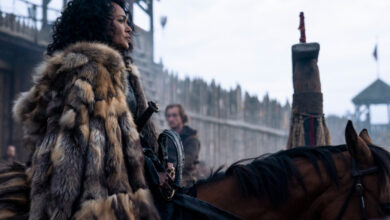True Detective – Night Country Episode 3 Analysis: Between Illustrious Quotes and Unexpected Revelations
Discovering the True Detective – Night Country episode 3. Symbols, narrative turns, colors. Adult men, big and fat, dead of fear, and then The Circle of Life: the cries of a newborn baby open the episode; the terrified cries of Annie K close it. The circle of life, in Ennis, is not natural. The third episode of True Detective: Night Country reminds us that Ennis is not a place like the others. The supernatural elements return, and there are many. Most importantly, we meet Annie K (Nivi Pedersen) for the first time. Because we need to figure out who the victim was. We need to know why Navarro (Kali Reis) cared so much about her. We must enter the world of a woman who helped others and fought to save her land.

True Detective – Night Country Episode 3 Analysis: Natural and Supernatural
As in episode 2, which we analyzed here, the internal/external, hot/cold, light/dark contrast is maintained throughout the narrative. To always remind us of where we are, but this time also to show us how the supernatural is always, in some way, linked to nature. Navarro sees an orange thrown back in the middle of nowhere. He falls while chasing someone on the ice (Travis?) and has a vision: a little boy in pajamas holding the one-eyed stuffed polar bear and whispering to her:
Tell my mom…”.
We already know who that child is, but that’s not what matters now. What matters is how Navarro follows his trail made up of ancient origins and native culture while Danvers (Jodie Foster) obsessively flaunts rationality. But there’s more. When the only surviving scientist, missing both legs and an arm, with his face and hand blackened by ice gangrene, awakens and speaks to Navarro about his mother, who greets her and is waiting for her, the supernatural dominates unchallenged.
Navarro tells us, through the dialogue with Kaviq – who quotes The Silence of the Lambs: Man wants a quid pro quo, I tell you something, you tell me something, as Doctor Lecter did with Clarice Starling, Jodie Foster, and the quid pro quo – his mother’s story. Navarro’s family has always been surrounded by the supernatural. From the mental illness that pushes him to pray and curse, to dream of disappearing. As Navarro herself tells Danvers, showing that she too has thoughts like those of her mother and sister Julia (Aka Niviâna), but she has something more than them: a reason to live. Solve the mystery of Annie’s death. Do justice. Find the culprit. Annie dreamed of the symbol she tattooed on her back, the spiral. We know what it represents from the analysis of episode 1, but the obsessive return of the supernatural – the dream that gives a message – is the hallmark of this episode and is always linked to Navarro. He always leads to her.
Liz Danvers
The absolute protagonist of this episode, despite the supernatural events involving Navarro, is Liz Danvers. We find out a lot about her, finally. We know she lies to Pete Prior (Finn Bennett) when she tells him about the murder-suicide that caused the rift between her and Navarro (William Wheeler was still alive when they arrived). When she tells him this story, she finds herself in the center of a room sitting on a cardboard box. The camera turns around her, in a circular pan, and then stops on the shocked face of Pete, who she listens to.
When he turns back to Danvers, the frame is on his face and it gets tighter and tighter. As she speaks, the camera rotates around her: she is telling the truth. When she stops and squeezes her face, comes the part where she lies. Danvers finds herself at the center of the situations that revolve around her: the cases. But then she has her point of view on things, which brings us closer to her. And they show us that he lies.

Again: the infinite tenderness that Liz shows towards children (Darwin, Susan’s little daughter, the newborn who is no longer there, so much so that she is the only white woman to pay homage to the mother who lost her son…) tells us his own story. Liz transforms when there is a baby. The swear words and harsh ways disappear. Liz Danvers goes from “I hate everyone” – as she tells Pete – to “I’ll tell you a story” without passing through an intermediate phase. Liz Danvers was a great mother. A fantastic mother, hardened by life.
She is very harsh with Leah (Isabella LaBlanc), with whom she has a very strong argument, and forces her to wash off the symbol painted on her chin. If before we didn’t know why, now we do: it’s the same tattoo Annie K. had. And Danvers has seen the photo of that symbol thousands of times on the face of a brutally murdered girl. He doesn’t want to have to associate Leah’s face with Annie’s even by mistake.
True Detective
There’s a sequence, about halfway through this episode, where Danvers and Navarro officially work together again. They open all the boxes of Clark’s things collected from the trailer and begin to examine them, in silence. Then they begin to think out loud, and Liz guides her colleague in the investigation, with her ritual phrase:
Ask the question.
Watching Danvers’ mind work is just as fascinating as watching Cohle (Matthew McConaughey) think in the first season. Here we are in Ennis, immersed in ice and perpetual night, in visions and whispers, but this is True Detective, and the third episode reminds us of this more than the others. A great moment in pure detective drama style marks the return of confidence between Danvers and Navarro, immediately. As if nothing had happened.
Two different women, with opposed approaches, prove complementary. And Danvers, as he always does with Pete, leads his colleague. Danvers teaches. Danvers enriches people. Even between one swear word and another and between one cup poured in Hank’s (John Hawkes) face and another. At least Pete doesn’t catch the reference to “playing Mrs. Robinson”, he certainly hasn’t seen The Graduate – the film with Dustin Hoffman in which Anne Bancroft seduces the young graduate, who then falls in love with her daughter.
The Mine
In the “natural” section of this episode, mine stands out. The black water coming out of the taps, the protests they are organizing – with Leah’s participation – the memory of Annie K’s actions against the mine that polluted her land. The mine, however, as the rational Danvers points out, employs half the population of Ennis, a city that would not exist without the mine. The theme of pollution to the detriment of health – birth mortality is skyrocketing in Ennis – recalls what, on an exponential scale, is happening in today’s world: we know very well that we are poisoning the planet, and consequently ourselves, but there we don’t care about it for economic purposes. Just like half the population of Ennis does.

So much so that the former scientist Oliver Tagaq (Lance Karmer) has taken refuge far away, in an isolated nomad camp, and if he initially seems willing to collaborate upon hearing Annie’s name, when questions arise about his former colleagues, now dead, what Oliver didn’t know, he’s ready to shoot the police chief. The mine, together with Annie – her first meeting with Navarro occurs when the policewoman comes to her to arrest her for damaging the mine – is the very reason why Oliver moved away first from the research station and then from the city. Ennis is shown in the center of darkness, illuminated by Christmas decorations in the dark. But the only lights that represent her are the red and blue of the police car’s siren as it drives away into the night.
Color Analysis
Red and blue, not surprisingly, are one of the symbols of this episode. But it’s still early for Red to have a dominant presence: we see him a lot in the hospital, but it’s not his time yet. To contrast the cold and darkness, yellow is used above all this time. The flashbacks are filtered with blue light, cold, distant in time but not in memory. The warmth of the place where Annie delivers the babies refers to the warm colors, yellow and red, as well as Leah’s room and a part of the house mourning the newborn.
The black of the night turns to blue while Navarro participates alone in Clark’s research, due to the effect of the ice that dilutes it. The alternation of cold and heat – with the interior of the police station being warm and the cold outside – contrasts the warm and cold colors. There is also a lot of yellow, I was saying, to indicate heat and represent light, contesting the darkness. Yellow, we all know, is the color of the sun’s rays, of golden light, it represents light as well as its opposite, black – in this episode declined in the dark blue of the night – is also its complementary color. Yellow is the color of nature, here contrasted with the supernatural. But yellow, according to different cultures, is an ambivalent color. In India, a golden knife was used for sacrifices because gold is light and immediately accompanies the sacrifice (editor’s note: horses, mainly) into the kingdom of the gods. But warm, golden yellow differs greatly from pale yellow, and in this episode, we find both. According to ancient Middle Eastern culture, golden yellow symbolizes wisdom and good advice, while yellow is associated with betrayal and deception. In short, everything is necessary to uncover the truth behind the lies and solve a case.
Blue is the color of the night; it marks the rhythms of human life. Just as yellow represents nature, blue is a symbol of the supernatural, of the divine, of what goes beyond earthly understanding. Blue is often associated with divinities, with gods wrapped in blue or dark blue cloaks, which reflect the color of the sky in which man imagines them to live and reign. If you notice, blue in this particular episode, but in the season in general, is often associated with Navarro. She is linked to the supernatural aspect, but also to divine faith. When she says to pray, Danvers mocks her by asking if she talks to God, but she replies:
No. I listen.
Danvers is surrounded by yellow, in all its variations, and warm colors, while Navarro is immersed in the night, in the sky, and spirituality. Confirming what the very first presentation of the characters had already told us.






